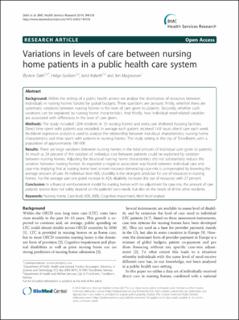Variations in levels of care between nursing home patients in a public health care system
Original version
Døhl, Øystein, Garåsen, Helge, Kalseth, Jorid, & Magnussen, Jon. (2014). Variations in levels of care between nursing home patients in a public health care system. BMC Health Services Research, 14 (1), 108. https://doi.org/10.1186/1472-6963-14-108Abstract
Background
Within the setting of a public health service we analyse the distribution of resources between individuals in nursing homes funded by global budgets. Three questions are pursued. Firstly, whether there are systematic variations between nursing homes in the level of care given to patients. Secondly, whether such variations can be explained by nursing home characteristics. And thirdly, how individual need-related variables are associated with differences in the level of care given.
Methods
The study included 1204 residents in 35 nursing homes and extra care sheltered housing facilities. Direct time spent with patients was recorded. In average each patient received 14.8 hours direct care each week. Multilevel regression analysis is used to analyse the relationship between individual characteristics, nursing home characteristics and time spent with patients in nursing homes. The study setting is the city of Trondheim, with a population of approximately 180 000.
Results
There are large variations between nursing homes in the total amount of individual care given to patients. As much as 24 percent of the variation of individual care between patients could be explained by variation between nursing homes. Adjusting for structural nursing home characteristics did not substantially reduce the variation between nursing homes. As expected a negative association was found between individual care and case-mix, implying that at nursing home level a more resource demanding case-mix is compensated by lowering the average amount of care. At individual level ADL-disability is the strongest predictor for use of resources in nursing homes. For the average user one point increase in ADL-disability increases the use of resources with 27 percent.
Conclusion
In a financial reimbursement model for nursing homes with no adjustment for case-mix, the amount of care patients receive does not solely depend on the patients’ own needs, but also on the needs of all the other residents.

